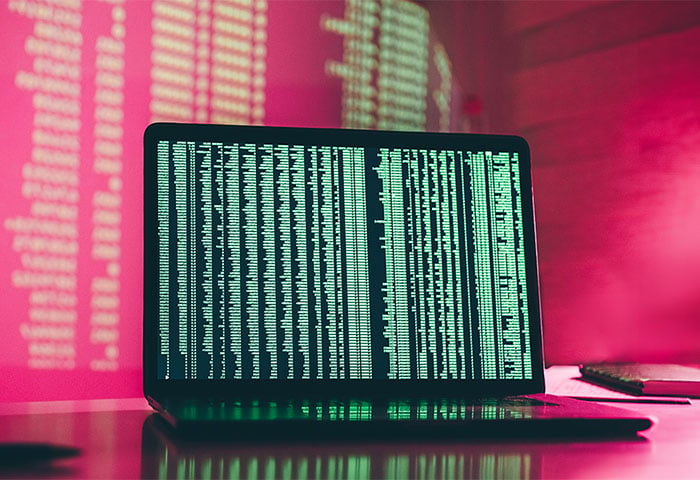What is malicious code?
Malicious code is any software or script designed to cause harm to computer systems or users, often capable of deleting important files or exposing sensitive information, for example. Harmful code typically enters your system through hacking incidents, compromised software, or security breaches, taking the form of harmful .exe files or hidden instructions embedded in malicious online advertisements.
Malicious code can cause harm in a variety of ways, including:
-
Stealing sensitive personal data for criminal use
-
Identifying and extracting data that can be held for ransom
-
Allowing a hacker to control your device remotely to facilitate schemes like cryptojacking
-
Overheating your computer, or individual components, to decrease its lifespan
While malware falls under the category of malicious code, the term “malicious code” is broader than just malware. Malware is standalone software that you have to download before it can harm you, whereas malicious code can also be packaged in scripts that run automatically when you visit a website.
Examples of malicious code attacks
Malicious code attacks take many forms — some dependent on you performing an action before they activate and others operating entirely automatically. Knowing how all of them work can help you understand the threats you’re dealing with so you can defend against the various types.
Here are some common examples of malicious code.
Computer virus
A computer virus spreads by copying itself between program files. Viruses can also often automatically send a copy of itself via email, instructing software on other devices to start deleting or exposing important files. If your device gets infected, you can use a virus removal tool to get rid of the harmful code.
Trojan horse
A Trojan horse is a computer program that appears to be harmless on the surface but contains a virus or malware hidden within. If a user installs and executes the program, it may be able to steal sensitive information, install additional malware, or create backdoors for unauthorized access.
This is one of the oldest malware code examples, and they’re so simple to make that even kids are writing them. Luckily, you can use a dedicated Trojan remover tool to detect and clear this type of malware.
Spyware
Spyware is a type of malware that’s designed to collect and transmit data to another device, typically owned by a cybercriminal. It can hide in legitimate software just like a Trojan and, when installed, poses a serious threat to the victim’s security and privacy. Using a good anti-spyware tool can help keep this type of malware off your device in the first place, and you can remove spyware from an iPhone or Android device relatively simply with the right security app.
 Spyware steals information from the target’s device.
Spyware steals information from the target’s device.
Worms
A worm is malicious code that attacks computers via network activity. Instead of reproducing across a single file system, worms spread across computers on a network. They’re often tough to spot at first, only revealing themselves when they’ve consumed large chunks of data and slowed your system down.
Worms differ from viruses because they don’t require a host file to spread and are self-replicating. While viruses can lie dormant without doing damage, a worm actively scans the network for vulnerable devices and can wreak havoc even when you’re not using the computer. However, the process for removing worms is similar to getting rid of malware.
Adware
Adware spams your computer with unwanted ads, usually in the form of pop-ups, banners, or notifications. The goal is often to generate revenue for the creators. Even though most adware isn’t harmful, the large number of ads can negatively affect your device’s performance by taking up resources. However, sometimes the ads can contain other types of malware, leaving you exposed to further risk.
Logic bombs
Logic bombs are a type of malicious code or software programmed to execute a harmful action when specific conditions are met. These conditions could include a particular date and time, the deletion of a file, or a certain number of system logins. The logic bomb remains dormant on your computer until the trigger is set off.
Logic bombs are often used by attackers to disrupt systems, delete data, or cause other damage. They can be embedded in legitimate software or delivered as part of a larger malware package.
 A logic bomb is malicious code that’s activated by specific criteria being met.
A logic bomb is malicious code that’s activated by specific criteria being met.
Backdoor attacks
Backdoor attacks attempt to gain unauthorized access to a device, website, or server, often facilitated by malicious code that’s installed on the target via malware, phishing, or software vulnerabilities.
The aim is typically to steal information, install further malware, and monitor user activity. Once a backdoor is installed on a device or network, the hacker can bypass normal authentication and security measures, meaning their activities can go unnoticed for long periods of time.
Scripting attacks
Scripting attacks occur when a hacker injects or adds malicious code into a website or app. The code is often in the form of JavaScript, a scripting language that’s commonly used on the internet. The attack is activated when a user visits the web page or app and interacts with a compromised element.
Once the script is executed, it can trigger a variety of actions like stealing data from tracking cookies, redirecting you to malicious websites, or capturing your keystrokes for use in a later hacking or account takeover attack.
How do you know you're under attack?
Malicious code is sneaky by design, so it can be hard to know when you’re at risk. However, changes to the way your device is performing are a generally reliable warning indicator of malicious code. Differences to note can include how long apps or web pages take to load, unfamiliar new programs appearing on your home screen or in your app drawer, and strange programs initiating on startup.
Here’s some more information about the signs you could be experiencing a malicious code attack:
-
Performance issues: If your device is slowing down for no obvious reason, and you haven’t made any recent changes like downloading new software, it could be the result of malicious code.
-
Unknown programs: If you notice unfamiliar programs you didn’t download, they could be running in the background and doing damage. Remove any apps you don’t recognize.
-
Unauthorized changes: If you notice changes to your system or browser settings, malicious code could have altered them automatically.
-
Repeated system crashes: If your computer constantly crashes or freezes, it could be the result of malicious code eating up processing power, system resources, or memory.
How to limit the damage from malicious code
You can limit damage from malicious code by disconnecting from the internet and running a scan with anti-malware software. If you’re not sure whether or not you’re safe from the malicious code attack, call an IT specialist. Since any malicious code you’re exposed to may have stolen your login details, you should also change your passwords and activate two-factor authentication (2FA) on your accounts.
How to prevent future attacks
To help prevent future malicious code attacks, work on upholding robust cybersecurity best practices. These can also keep you safer from other online threats.
Here are some of the best ways to help prevent future attacks:
-
Install and maintain robust antivirus software: Use AVG AntiVirus Free to continuously scan for threats. Not only will it help keep you safer from malicious code, but it also comes with powerful anti-scam protection.
-
Use strong passwords: Create strong passwords for all your online accounts and make sure each one is unique. They should be at least 15 characters long for the best protection. Also consider enabling 2FA on any accounts where it’s available in case your passwords are ever stolen or leaked.
-
Be vigilant with links and attachments: Don’t open an attachment or link unless you’re completely sure it’s trustworthy. If you think an email or text is a phishing scam, don’t interact with it. Instead, delete and report it straight away.
-
Block pop-ups: Pop-ups might seem like minor annoyances, but they could be hiding malicious code designed to infect your computer. They can also redirect you to malicious websites or download malware if you click on one, so use a reliable pop-up blocker to help avoid the risk.
-
Install a firewall: A firewall helps protect your devices and network from unauthorized access. A good firewall can stop hackers from directly injecting malicious code into your system or exploiting vulnerabilities.
-
Use a VPN: You can mask your online activity by using a VPN with bank-grade encryption, like AVG SecureVPN. While it doesn’t directly stop malicious code, it helps prevent attackers from intercepting sensitive data like login credentials that could be used to inject malicious code.
-
Install updates: Keep your operating system and software updated to make sure you benefit from the latest security patches. If you’re on a PC, then you need to keep your drivers updated too. You can use a driver updater like AVG Driver Updater to do this automatically.
Protect against malicious code with AVG
Malicious code poses a real threat to your security and privacy. Get AVG AntiVirus Free to help defend against attacks, hackers, malware, and even online scams. You’ll enjoy unintrusive 24/7 protection for free. With more than 30 years of experience, you can see why our antivirus is one of the most trusted around. Get it today.
.png)
.png)













/What-is-scareware-and-how-to-remove-it-Thumb-Signal.jpg)
/What-is-a-logic-bomb-and-how-to-prevent-it-Thumb.jpg)


